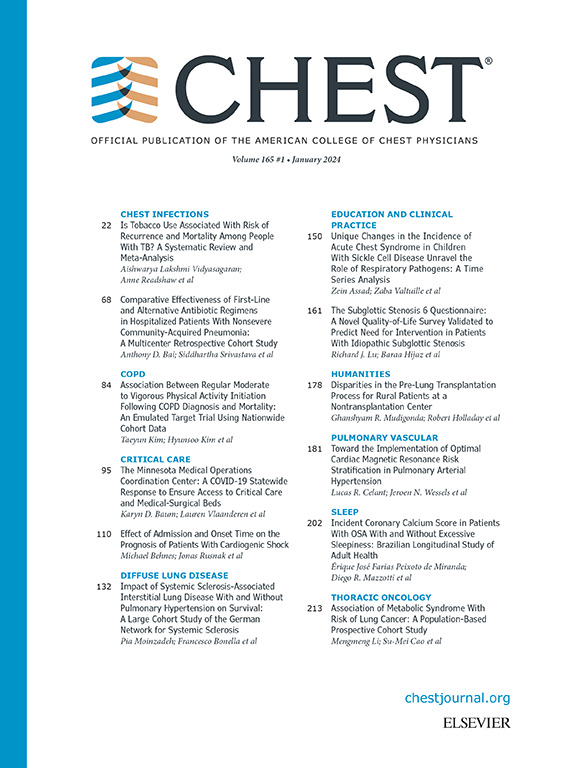机器人辅助支气管镜安全性和诊断结果的前瞻性多中心评估:机器人指导下肺肿瘤评估(TARGET)试验的经支气管活检结果
IF 9.5
1区 医学
Q1 CRITICAL CARE MEDICINE
引用次数: 0
摘要
安全可靠地对肺周围病变(ppl)进行活检仍然具有挑战性。机器人辅助支气管镜(RAB)在ppl导航中的应用越来越广泛。然而,来自大型研究的证据仍然有限。研究问题:在现实世界中,RAB用于ppl活检的临床安全性、导航成功率和诊断率是什么?研究设计和方法:这项多中心、前瞻性、单臂研究纳入了年龄在21岁、8-50毫米肺部病变需要支气管镜诊断的患者。主要终点是以下设备或手术相关事件的发生率:(1)需要干预的气胸;(2)出血需要干预;或(3)呼吸衰竭。次要终点包括主要终点的各个组成部分,手术时间,气胸,桡骨探头支气管内超声(R-EBUS)确认,转换为另一种活检程序,并发症和诊断率(DY)。结果在21个地点的715例患者中,679例符合研究标准并接受了RAB(平均年龄68.7岁,女性55.4%,白人86.5%,当前/过去吸烟者77.5%)。病灶大小平均(范围)为20.9 (7.0 ~ 63.0)mm;距胸膜表面的中位数(IQR)距离为5 (0-16)mm。大多数病变为实性(n=587;86.6%)和肺外三分之二(n=593;87.5%)。26例(3.8%)患者观察到主要终点(19例气胸,7例出血,0例呼吸衰竭)。用户报告,670/679例(98.7%)患者的RAB到达病灶,607/662例(91.7%)患者的R-EBUS确认病灶位置;675/679例(99.4%)经支气管镜取样。12个月恶性肿瘤发生率为64.1%。根据严格报告标准的美国胸科学会(ATS)/美国胸科医师学会(ACCP)定义计算,判定死亡率为61.6%。对恶性肿瘤的敏感性为78.8%。这项迄今为止规模最大的RAB多中心前瞻性研究表明,RAB引导的ppl取样是安全的,并且与大规模非机器人支气管镜研究的结果相比更有利。临床试验注册号:04182815。本文章由计算机程序翻译,如有差异,请以英文原文为准。
A Prospective, Multicenter Evaluation of Safety and Diagnostic Outcomes with Robotic-Assisted Bronchoscopy: Results of the Transbronchial Biopsy Assisted by Robot Guidance in the Evaluation of Tumors of the Lung (TARGET) Trial.
BACKGROUND
It remains challenging to safely and reliably biopsy peripheral pulmonary lesions (PPLs). Robotic-assisted bronchoscopy (RAB) is gaining adoption for navigation to PPLs. However, evidence from large studies remains limited.
RESEARCH QUESTION
What is the clinical safety, navigational success, and diagnostic yield of RAB for biopsy of PPLs in a broad range of patients in a real-world setting?
STUDY DESIGN AND METHODS
This multicenter, prospective, single-arm study enrolled patients >21 years old with 8-50 mm lung lesions requiring bronchoscopic diagnosis. The primary endpoint was the incidence of the following device- or procedure-related events: (1) pneumothorax requiring intervention; (2) bleeding requiring intervention; or (3) respiratory failure. Secondary endpoints included individual components of the primary endpoint, procedure time, pneumothoraces, radial probe endobronchial ultrasound (R-EBUS) confirmation, conversion to an alternative biopsy procedure, complications, and diagnostic yield (DY).
RESULTS
Among 715 patients at 21 sites, 679 met study criteria and underwent RAB (mean age 68.7, 55.4% female, 86.5% White, 77.5% current/past tobacco users). Mean (range) lesion size was 20.9 (7.0-63.0) mm; median (IQR) distance from pleural surface was 5 (0-16) mm. Most lesions were solid (n=587; 86.6%) and within the outer two-thirds of the lung (n=593; 87.5%). The primary endpoint was observed in 26 (3.8%) patients (19 pneumothorax, 7 bleeding, 0 respiratory failure). Users reported that RAB reached the lesion in 670/679 (98.7%) cases, and lesion location was confirmed with R-EBUS in 607/662 (91.7%) cases; sampling through the bronchoscope was performed in 675/679 (99.4%) cases. Prevalence of malignancy was 64.1% through 12 months. Adjudicated DY was 61.6% when calculated with the American Thoracic Society (ATS)/American College of Chest Physicians (ACCP) definition for strict reporting criteria. Sensitivity for malignancy was 78.8%.
INTERPRETATION
This largest multicenter prospective study of RAB to date demonstrated that RAB-guided sampling of PPLs is safe and compares favorably to results from sizable non-robotic bronchoscopy studies.
CLINICAL TRIAL REGISTRATION NUMBER
NCT04182815.
求助全文
通过发布文献求助,成功后即可免费获取论文全文。
去求助
来源期刊

Chest
医学-呼吸系统
CiteScore
13.70
自引率
3.10%
发文量
3369
审稿时长
15 days
期刊介绍:
At CHEST, our mission is to revolutionize patient care through the collaboration of multidisciplinary clinicians in the fields of pulmonary, critical care, and sleep medicine. We achieve this by publishing cutting-edge clinical research that addresses current challenges and brings forth future advancements. To enhance understanding in a rapidly evolving field, CHEST also features review articles, commentaries, and facilitates discussions on emerging controversies. We place great emphasis on scientific rigor, employing a rigorous peer review process, and ensuring all accepted content is published online within two weeks.
 求助内容:
求助内容: 应助结果提醒方式:
应助结果提醒方式:


